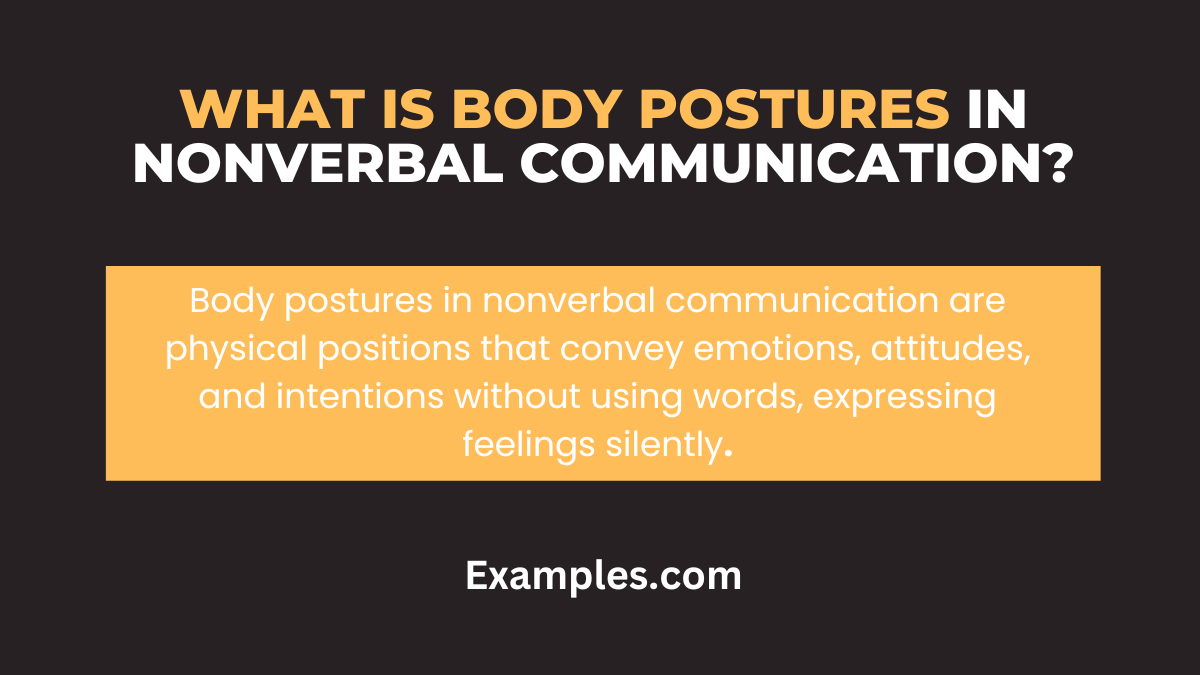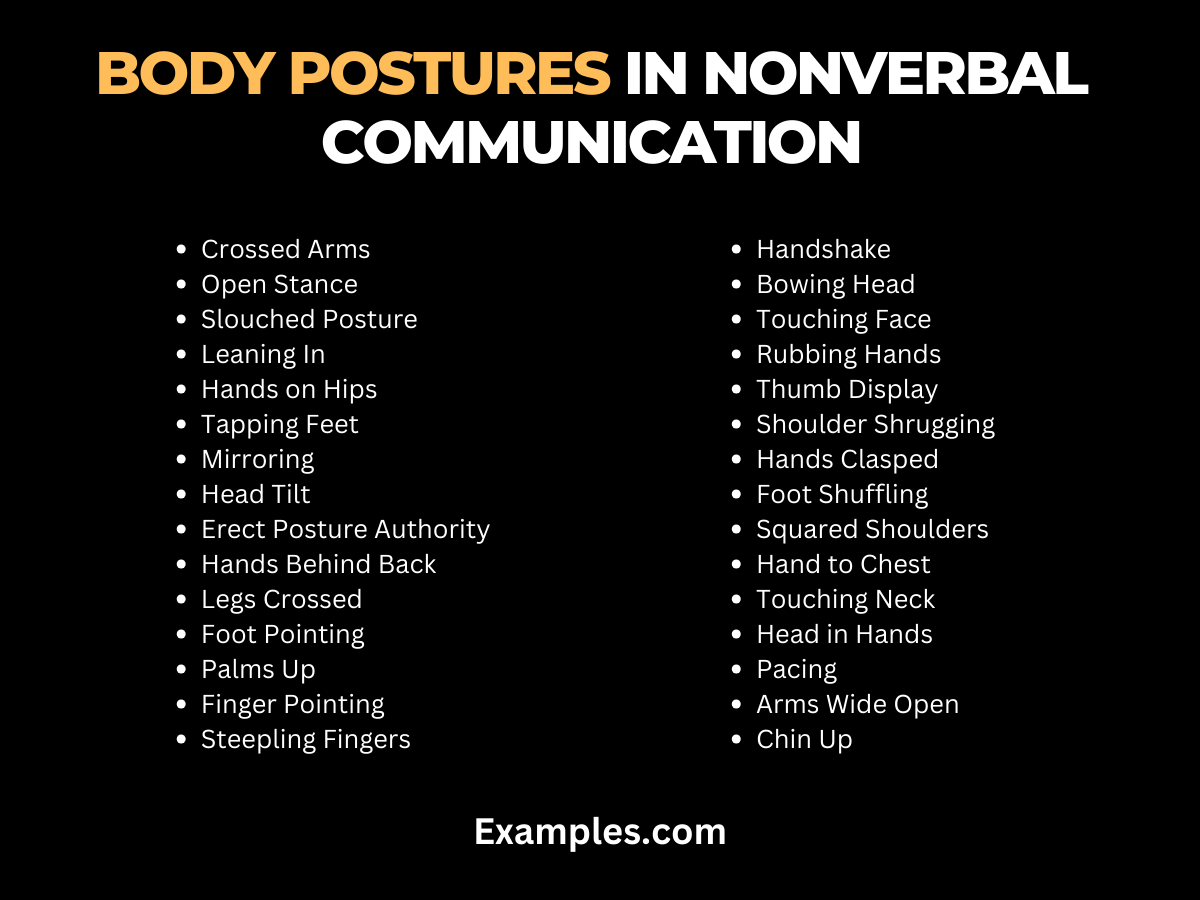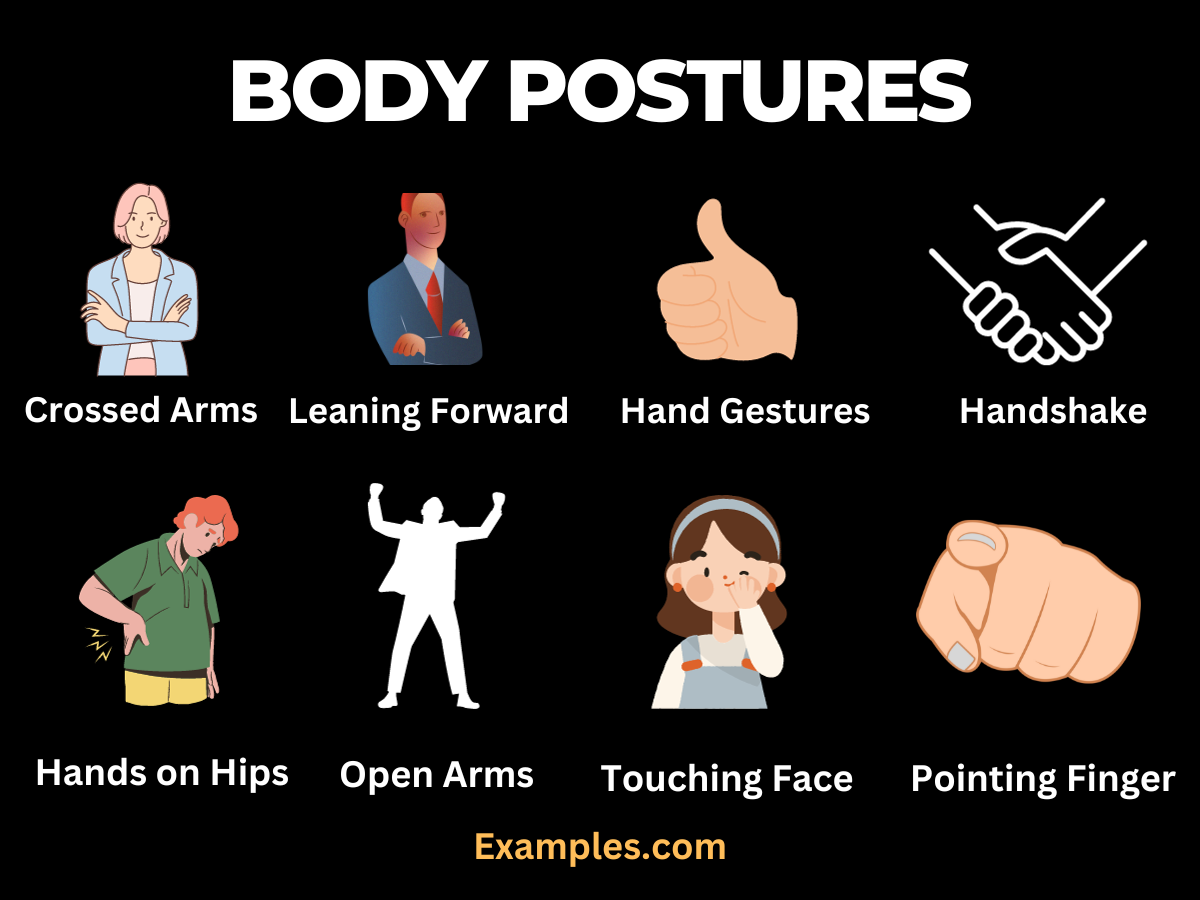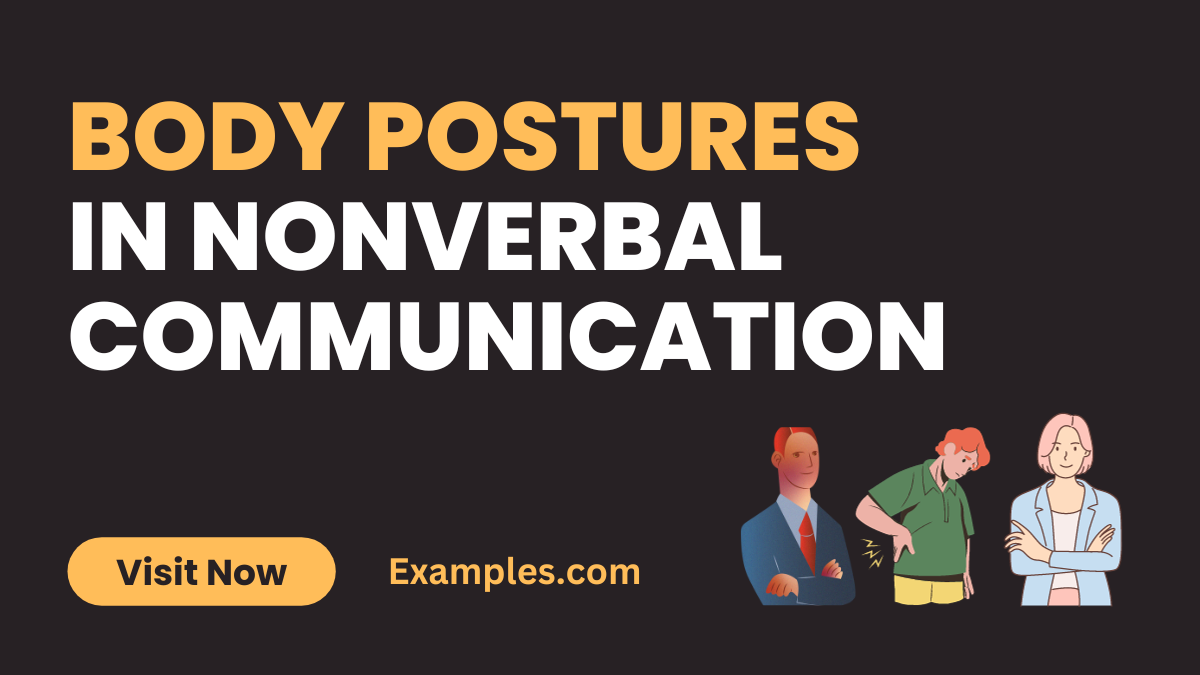29+ Body Postures in Nonverbal Communication Examples
In the realm of nonverbal cues, body postures stand out as silent yet powerful communicators. This comprehensive guide delves into the nuances of body language, presenting practical communication examples to enhance your understanding. Explore how different postures can convey confidence, openness, or defensiveness, and learn to interpret these silent signals in various contexts. From professional settings to personal interactions, mastering body postures is key to enriching your nonverbal communication skills.
What are Body Postures in Nonverbal Communication?

Body postures in nonverbal communication refer to the physical stance, positioning, and movements of a person’s body that convey messages without spoken words. They are a crucial aspect of nonverbal cues, offering insights into a person’s feelings, attitudes, and intentions. Understanding these silent signals can significantly enhance interpersonal interactions and communication effectiveness.
What is the best Example of Body Postures in Nonverbal Communication?

One of the best examples of body postures in nonverbal communication is the open versus closed posture. An open posture, with uncrossed arms and a relaxed stance, typically indicates approachability and willingness to engage. In contrast, a closed posture, like crossed arms or legs, might signal defensiveness or disinterest. Recognizing and interpreting these postures can greatly aid in understanding and improving nonverbal communication dynamics.
30 Examples of Body Postures in Nonverbal Communication

Body postures play a vital role in nonverbal communication, often speaking louder than words. From professional settings to social interactions, understanding these postures is key in deciphering underlying messages and emotions. Here are 30 examples of body postures in nonverbal communication, each with a brief explanation and an example sentence.

- Crossed Arms: Indicates defensiveness or resistance.
Example: “As he discussed the new policy, his crossed arms suggested he wasn’t open to change.” - Open Stance: Shows openness and receptiveness.
Example: “Her open stance during the meeting invited more collaborative discussion.” - Slouched Posture: Can imply disinterest or lack of energy.
Example: “His slouched posture during the presentation made him seem unenthusiastic.” - Leaning In: Suggests interest and engagement.
Example: “Leaning in during the conversation, she showed genuine interest in the topic.” - Hands on Hips: Often signifies readiness or aggression.
Example: “Standing with her hands on her hips, she appeared confrontational.” - Tapping Feet: Indicates impatience or nervousness.
Example: “His tapping feet under the table betrayed his anxiety.” - Mirroring: Reflects agreement or rapport.
Example: “They mirrored each other’s posture, indicating a strong connection.” - Head Tilt: Shows curiosity or contemplation.
Example: “Her head tilt showed she was pondering the question deeply.” - Erect Posture: Conveys confidence and authority.
Example: “His erect posture commanded respect in the boardroom.” - Hands Behind Back: Can indicate authority or contemplation. ?
Example: “Walking with his hands behind his back, he seemed deep in thought.” - Legs Crossed: Often seen as a sign of comfort or self-protection.
Example: “Sitting with her legs crossed, she seemed at ease yet guarded.” - Foot Pointing: Indicates interest in the direction or person it points to. ?
Example: “Her foot pointing towards the exit suggested she wanted to leave.” - Palms Up: Shows honesty or submission.
Example: “With palms up, he conveyed his sincerity.” - Finger Pointing: Can be perceived as accusatory or commanding.
Example: “His finger pointing during the argument was seen as aggressive.” - Steepling Fingers: Indicates confidence or self-assuredness.
Example: “Steepling her fingers, she exuded confidence in her decision.” - Handshake: Varies from firm (confidence) to weak (hesitancy).
Example: “His firm handshake conveyed a strong sense of self-assurance.” - Bowing Head: Shows respect or submission.
Example: “Bowing his head, he showed deep respect for the elders.” - Touching Face: Can indicate thinking or uncertainty.
Example: “Touching her face frequently, she seemed unsure about the proposal.” - Rubbing Hands: Often shows eagerness or anticipation.
Example: “Rubbing his hands together, he awaited the results eagerly.” - Thumb Display: Represents authority or assertiveness.
Example: “His thumbs sticking out of his pockets indicated a sense of authority.” - Shoulder Shrugging: Implies uncertainty or indifference.
Example: “Her shoulder shrug showed she was indifferent to the decision.” - Hands Clasped: Signifies restraint or self-control.
Example: “With hands clasped, he patiently listened to the feedback.” - Foot Shuffling: Indicates discomfort or lack of confidence.
Example: “His foot shuffling revealed his discomfort during the interrogation.” - Squared Shoulders: Suggests readiness or determination.
Example: “Her squared shoulders displayed her determination to face the challenge.” - Hand to Chest: Shows sincerity or gratitude.
Example: “Placing her hand on her chest, she expressed heartfelt thanks.” - Touching Neck: Often a sign of insecurity or stress.
Example: “He touched his neck frequently when asked difficult questions.” - Head in Hands: Can indicate despair or frustration.
Example: “With his head in his hands, he conveyed deep frustration.” - Pacing: Reflects anxiety or deep thought.
Example: “Pacing back and forth, he was clearly anxious about the decision.” - Arms Wide Open: Indicates welcoming or acceptance.
Example: “With arms wide open, she greeted the newcomers warmly.” - Chin Up: Portrays confidence or defiance.
Example: “With her chin up, she faced the criticism unflinchingly.”
Importance of Body Postures in Nonverbal Communication
- Conveys Emotions: Body postures often reflect a person’s emotional state, such as confidence, nervousness, or openness.
- Enhances Verbal Messages: Posture can strengthen the impact of verbal communication, adding emphasis or sincerity.
- Cultural Significance: Different cultures interpret postures in various ways, making understanding them key in cross-cultural communication.
- First Impressions: Initial judgments are often based on posture, affecting how individuals are perceived.
- Indicates Interest or Boredom: Leaning forward typically shows interest, while slouching can imply disinterest or boredom.
- Regulates Conversations: Subtle changes in posture can signal a desire to speak or indicate that one is listening.
- Reveals Power Dynamics: Dominant or submissive postures can indicate an individual’s perceived status in a group.
- Aids in Conflict Resolution: Open and relaxed postures can de-escalate tensions in conflicts.
- Enhances Persuasiveness: Effective postures can make a speaker appear more convincing and trustworthy.
- Improves Personal Relationships: Appropriate body postures can create a sense of warmth and approachability.
Role of Body Postures in Nonverbal Communication
- Communication Without Words: Postures convey messages in situations where verbal communication is limited or unnecessary.
- Reflects Psychological States: Postures can reveal hidden feelings or attitudes, like crossed arms indicating defensiveness.
- Facilitates Nonverbal Feedback: Listeners use postures to provide nonverbal feedback to the speaker.
- Influences Social Interaction: Posture affects how people interact in social situations, impacting relationships and conversations.
- Enhances Public Speaking: Effective postures during speeches or presentations can engage and influence the audience.
- Signals Readiness or Hesitancy: Posture can indicate a person’s readiness to participate or hesitation.
- Enhances Professional Image: Professional postures in the workplace convey competence and confidence.
- Impacts Health and Communication: Good posture also has health benefits and can positively influence how we communicate.
- Interprets Silent Messages: Decoding postures can provide insights into unspoken thoughts or feelings.
- Adapts to Context: Posture changes according to the context, be it formal, casual, or intimate.
Tips to Improve Body Postures in Nonverbal Communication
- Maintain an Open Stance: Keep your arms uncrossed and body open to seem approachable.
- Align Your Posture: Ensure your head, shoulders, and hips are aligned for a confident stance.
- Practice Good Sitting Habits: Sit upright with your feet flat on the floor during meetings or conversations.
- Use Mirroring Techniques: Subtly mimic the posture of your conversation partner to build rapport.
- Stay Relaxed: Avoid stiffness in your posture; a relaxed body conveys ease and openness.
- Be Aware of Personal Space: Respect others’ personal space to avoid nonverbal signals of intrusion.
- Use Gestures Appropriately: Complement your posture with appropriate hand gestures for emphasis.
- Practice Posture Exercises: Regular exercises can help improve posture and body awareness.
- Record and Review: Video recording yourself can help identify and correct unhelpful postures.
- Seek Feedback: Ask for feedback on your posture in different communication settings to improve.
In conclusion, the significance of body postures in nonverbal communication cannot be overstated. As explored in this guide, body postures are a crucial aspect of nonverbal cues, providing insights into a person’s feelings, attitudes, and intentions without spoken words. They play an instrumental role in enhancing interpersonal interactions and communication effectiveness, from professional settings to personal interactions.
Understanding and effectively utilizing body postures can greatly enhance communication skills. For example, an open posture can communicate approachability and willingness to engage, while a closed posture may signal defensiveness or disinterest. These nonverbal cues complement verbal communication, strengthen the impact of spoken words, and are essential in cross-cultural communication. They also play a vital role in first impressions, indicating interest or boredom, and can regulate conversations, reveal power dynamics, aid in conflict resolution, enhance persuasiveness, and improve personal relationships. Moreover, body postures communicate without words, reflect psychological states, facilitate nonverbal feedback, influence social interaction, enhance public speaking, signal readiness or hesitancy, enhance professional image, and adapt to context.



